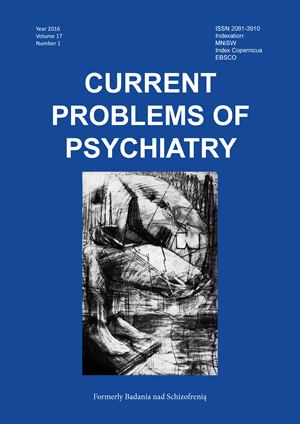Mechanisms promoting and inhibiting the process of proteasomal degradation of cells
DOI:
https://doi.org/10.1515/cpp-2016-0007Keywords:
proteasome, lysosome, UPS – ubiquitin-proteasome systemAbstract
Defects in the process of degradation of unneeded cellular proteins underlie many diseases. This article discusses one of the most important systems of removal of abnormal proteins. It describes the process of ubiquitination of proteins for proteasome degradation. It also describes the structure of the 26S and 20S proteasomes and the mechanism of ubiquitin-proteasome system. Proteasome proteolytic system is highly specialized and organized. Protease-proteasome 26S is particularly important for proper cell functioning. It recognizes and degrades marked proteins. Inhibition of proteasome pathway leads to cell cycle arrest and apoptosis.
Efficient degradation of cellular proteins by UPS (the ubiquitin – proteasome system) – is important for signal transduction, transcriptional regulation, response to stress and the activity control of cell receptors.
The development of many diseases has its origin in the dysfunction of the UPS route. This group includes diseases such as cancer, neurodegenerative disorders, immunemediated diseases and infectious diseases. Development of effective methods for pharmacological intervention in the functioning of this system has become a great challenge. The use of specific, low molecular-weight proteasome inhibitors and enzymes catalyzing the ubiquitination gives hope for new, targeted therapies.
References
1. Borissenko L., Groll M.: 20S proteasome and its inhibitors: crys-tallographic knowledge for drug development. Chem Rev. 2007; 107:687-717.
2. O’Neill L.A., Bryant C.E., Doyle S.L.: Therapeutic targeting of Toll-like receptors for infectious and inflammatory diseases and can-cer. Pharmacol. Rev., 2009; 61: 177-197.
3. Tsou W.L., Sheedlo M.J., Morrow M.E., Blount J.R., McGregor K.M., Das C., Todi S.V.: Systematic analysis of the physiological importance of deubiquitinating enzymes. PLoS One, 2012; 7: e43112.
4. Bury M., Niemierko A.: Proteasomalna degradacja białek komór-kowych. Postępy Biol. Kom., 2005; 32: 435-448.
5. Grzelakowska-Sztabert B.: Nagroda Nobla z chemii za 2004 rok - docenienie kontrolowanej, zależnej od ubikwityny, proteolitycz-nej degradacji białek. Postępy Biol. Kom., 2005; 32: 3-12.
6. Jurczyszyn A., Skotnicki A.B.: Proteasome inhibition as a novel therapeutic target in neoplasmatic diseases. Adv. Clin. Exp. Med., 2006; 15: 309–320.
7. Rechsteiner M., Realini C., Ustrell V.: The proteasome activator 11 S REG (PA28) and class I antigen presentation. Biochem. J., 2000; 345: 1-15.
8. Myung J., Kim K.B., Crews C.M.: The ubiquitin-proteasome pathway and proteasome inhibitors. Med. Res. Rev., 2001; 21: 245-273.
9. Wolf D.H., Hilt W.: The proteasome: a proteolytic nanomachine of cell regulation and waste disposal. Biochim. Biophys. Acta, 2004; 1695: 19-31.
10. Kisselev A.F., Callard A., Goldberg A.L.: Importance of the different proteolytic sites of the proteasome and the efficacy of inhibitors varies with the protein substrate. J. Biol. Chem., 2006; 281: 8582-8590.
11. Richardson P.G., Mitsiades C., Hideshima T., Anderson K.C.: Proteasome inhibition in the treatment of cancer. Cell Cycle, 2005; 4: 290-296.
12. Sprangers R., Kay L.E.: Quantitative dynamics and binding studies of the 20S proteasome by NMR. Nature, 2007; 445: 618-622.)
13. Navon A., Ciechanover A.: The 26 S proteasome: from basic mechanisms to drug targeting. J. Biol. Chem., 2009; 284: 33713-33718.
14. Sorokin A.V., Kim E.R., Ovchinnikov L.P.: Proteasome system of protein degradation and processing. Biochemistry, 2009; 74: 1411-1442.
15. Xie Y.: Structure, assembly and homeostatic regulation of 26S proteasome. J. Mol. Cell Biol., 2010; 2: 308-317.
16. Maliński M., Cichocki M.: Inhibicja aktywności proteasomu, jako nowa strategia w terapii i chemioprewencji nowotworów. Postępy Hig. Med. Dośw., 2013; 67: 90-106.
17. Miller Z., Ao L., Kim K.B., Lee W.: Inhibitors of the immunoproteasome: current status and future directions. Curr. Pharm. Des.,2013; 19: 4140-4151.
18. Glickman M.H., Ciechanover A.: The ubiquitin-proteasome proteolytic pathway: destruction for the sake of construction. Physiol. Rev., 2002; 82: 373-428.
19. Murata S., Takahama Y., Tanaka K.: Thymoproteasome: probable role in generating positively selecting peptides. Curr. Opin. Immunol., 2008; 20: 192-196.
20. Ikeda F., Crosetto N., Dikic I.: What determines the specificity and outcomes of ubiquitin signaling? Cell, 2010; 143: 677-681.
21. Mukhopadhyay D., Riezman H.: Proteasome-independent func-tions of ubiquitin in endocytosis and signaling. Science, 2007; 315: 201-205.
22. Pandey U.B., Nie Z., Batlevi Y., McCray B.A., Ritson G.P., Nedelsky N.B., Schwartz S.L., DiProspero N.A., Knight M.A., Schuldiner O., Padmanabhan R., Hild M., Berry D.L., Garza D., Hubbert C.C., Yao T.P., Baehrecke E.H., Taylor J.P.: HDAC6 rescues neurodegeneration and provides an essential link between au-tophagy and the UPS. Nature, 2007; 447: 859-863.
23. Martinez-Forero I., Rouzaut A., Palazon A., Dubrot J., MeleroI.: Lysine 63 polyubiquitination in immunotherapy and in cancer-promoting inflammation. Clin. Cancer Res., 2009; 15: 6751-6757.
24. Tsou W.L., Sheedlo M.J., Morrow M.E., Blount J.R., McGregor K.M., Das C., Todi S.V.: Systematic analysis of the physiological importance of deubiquitinating enzymes. PLoS One, 2012; 7: e43112.
25. Ciechanover A.: Intracellular protein degradation: from a vague idea thru the lysosome and the ubiquitin-proteasome system and onto hu-man diseases and drug targeting. Hematology, 2006; 1-12: 505-506.
26. Paul S.: Dysfunction of the ubiquitin-proteasome system in multiple disease conditions: therapeutic approaches. Bioessays, 2008; 30: 1172-1184.
27. Dziewulska D., Rafałowska J.: Rola zaburzeń przestrzennej bu-dowy białek w patomechanizmie chorób układu pozapiramido-wego. Neurol. Neurochir. Pol., 2005; 39: 397-404.
28. Nukina N.: Pathomechanism of polyglutamine diseases and strategic design for their therapies. Rinsho Shinkeigaku, 2008; 48: 913-914.
29. Seo H., Sonntag K.C., Kim W., Cattaneo E., Isacson O.: Proteasome activator enhances survival of Huntington's disease neuronal model cells. PLoS One, 2007; 2: e238.
Downloads
Published
Issue
Section
License
Copyright (c) 2016 Authors

This work is licensed under a Creative Commons Attribution-NonCommercial-NoDerivatives 3.0 Unported License.


